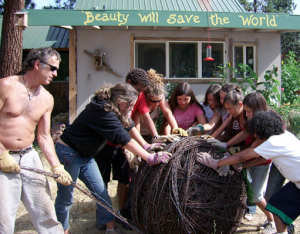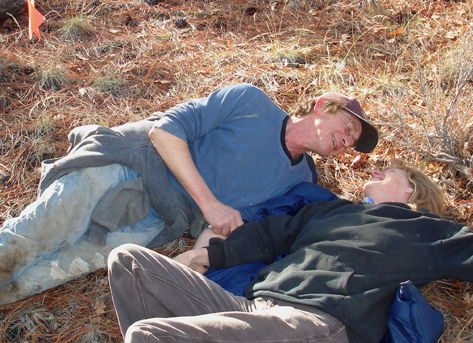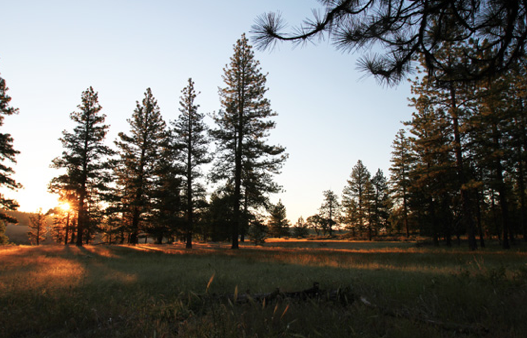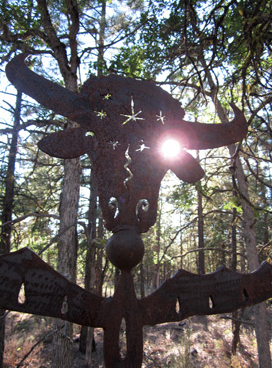We spoke with Chris Woodcock of the White Eagle Memorial Preserve, a trustee and founding member of the green burial site. Established in Washington state in 2008, White Eagle hopes to make “each gravesite an opportunity to nourish [the earth]” and exist “as a living memorial” for nature. The cemetery is within 20 acres of White Eagle’s collective 1100, and currently the country’s only wilderness cemetery.
MaryFrances: What is the White Eagle Memorial Preserve? And how was it established?
Chris: It is a natural burial ground outside of Goldendale, Washington. [White Eagle’s] land trust was first established in 1972 by a fellow named Ray Mitchell, who bought 160 acres here and throughout his life added acreage upon acreage. Preserving this beautiful land became his mission. He was a horse person and started a summer camp here eight years ago, so we continue that tradition today. He had a heart attack five years ago and left us and there was no question whatsoever that he needed to be buried out here.
I’ve been [working] here about 20 years, and establishing a burial ground was something that had always been on our radar. We had read the articles and had that dream out there, but we hadn’t taken the steps to actualize it until we had to with Ray; when he died we were set into motion. We spent several months jumping through the hoops to get those 20 acres of the land trust dedicated towards being a cemetery.
MaryFrances: It’s very unique to have a summer camp and a cemetery in the same space. Is there a more open dialogue about death for the campers?
Chris: Absolutely. I mean, when we lost Ray so suddenly everyone was grieving. Especially his campers. And we were able to share our grief and take them out to his gravesite, to talk about him transforming back into the earth; [to talk] about the immortality of humans. It’s been a good and unusual integration between summer camp and cemetery. We’re able to talk to [the kids] about [death] and prepare them if a burial party is coming through.

Summer camp kids in the creation of a giant barbed wire ball made of area fences permanently removed from the land. Photo Credit: White Eagle Memorial Preserve
MaryFrances: How has White Eagle evolved in the past five years?
Chris: Well, five years ago our first burial was Ray. We hand-dug the site for him in his favorite spot on the land. We’ve been learning [things] as we go; we originally thought we needed to bury bodies at six feet, but just learned two [suffices].
MaryFrances: What is the philosophy attached to a green burial? What makes it so important today?
Chris:Well, we’re learning that natural is the best way to go. I think that in the sixties and seventies people got really into home-birth and midwifery, that sort of thing. And now, [those of us] who were doing that then are facing end-of-life issues and of course we want to [die] just as naturally.
Chris Woodcock’s 3 Considerations When Planning a Green Burial
1) Make a plan of your green burial wishes and write it down!
2) Include what’s important to you like a favorite song or poem.
3) Keep your green burial plan along with important papers to be easily found
by your loved ones.
Chris: You know, I’m not a chemist. I’ve been doing some research about [embalming] and it just seems poisonous, it feels poisonous. My daughter was just reminiscing about seeing two of her grandparents buried who were embalmed. Just knowing that their bodies would never decompose doesn’t seem right. I couldn’t debate it scientifically, but it doesn’t seem like a good thing to be putting in the earth.

White Eagle trustees Bob and Chris cozy up on the burial site they picked out and
marked. Photo Credit: White Eagle Memorial Preserve
There are certain situations where it is necessary. I know that [embalming] came to be in this country during the Civil War, when they were really striving to get bodies returned to families. More often than not, though, I think it’s not necessary. Get the body in the ground quickly and let it decompose naturally. Nourish a tree!
MaryFrances: What makes a White Eagle burial different?
Chris: The weather dictates a lot of what happens. Sometimes you have to go down a long dirt road to get to the cemetery grounds. There are times when that’s easier and harder; times when we’ve had to rely on horse or even donkey to take a body down there. There was a time when a rattlesnake traveled past us during a burial! It’s just so in touch with the magic of nature.
MaryFrances:What are some of the requirements for being buried at White Eagle?
Chris: Well, we have rules about headstones. We allow families to choose a native rock that we then engrave. We don’t bring in anything that’s not indigenous; no plastic flowers. And because we are also a working ranch we’re [only] open for visitation the first weekend of each month and on certain holidays. If a person needs to make special accommodations they can of course give us a call, but we’re just not open 24/7.
MaryFrances: Do you have any end-of-life preparation tips for our readers?
Chris: Make a plan and write it down! Keep that plan with important papers. Save your loved ones from having to make more hard decisions when the time comes. If they can find a piece of paper with your wishes—your favorite song, poem, something like that—it’s going to [be] easier on the family. And it’ll be just want you want!
MaryFrances: What’s next for White Eagle?
Chris: We’re training some of our horses to pull the wagons and hearses to burial sites. To be able to do most burial processions with a horse and wagon, that’s a dream of ours that will come to fruition very soon.
MaryFrances: Thanks for chatting with us today!
Chris: Thank you!
Related Articles:
- Poetree: The Innovative Urn
- What is Green Cremation? An Interview with George Frankel
- Green Burial Makes its Way to South Africa

 What is Green Burial? An Interview with Chris Woodcock
What is Green Burial? An Interview with Chris Woodcock




 First the Wealth Gap, Now the U.S. Has a Growing Health Gap
First the Wealth Gap, Now the U.S. Has a Growing Health Gap

 Our Annual Seven Holiday Gifts for Someone Who Is Grieving, 2024 Edition
Our Annual Seven Holiday Gifts for Someone Who Is Grieving, 2024 Edition














